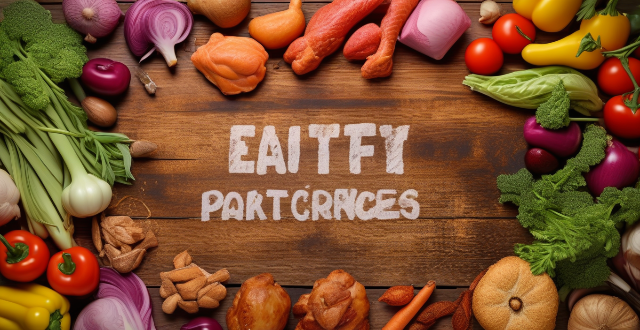Fresh Meat

Can reducing meat consumption lower my carbon footprint ?
Reducing meat consumption can lower your carbon footprint by decreasing the demand for livestock, which produces greenhouse gases and requires significant resources. This dietary change also conserves water and land, improves health, and supports a more sustainable food system.

What are the best practices for handling and preparing raw meat to prevent contamination ?
To prevent contamination when handling and preparing raw meat, it is essential to wash hands before and after handling the meat, clean utensils and surfaces with hot, soapy water or a bleach solution, keep raw meat cold in the refrigerator or freezer, avoid cross-contamination by not letting raw meat come into contact with ready-to-eat foods, cook meat thoroughly using a food thermometer, and store cooked meat properly in the fridge or freezer. By following these best practices, you can ensure that the meat you prepare is safe to eat and reduce the risk of contaminating your kitchen.

How do I make a quick and satisfying sandwich ?
How to Make a Quick and Satisfying Sandwich A sandwich is an easy meal that can be customized in many ways. Here are some steps for making a tasty sandwich: Ingredients: - Bread (any type) - Meat (ham, turkey, chicken, etc.) - Cheese (any type) - Lettuce - Tomatoes - Onions - Condiments (mustard, mayonnaise, ketchup, etc.) Steps: 1. Toast the bread slices until lightly browned for a crispier texture. 2. Add cold cuts like ham or turkey, or grilled meat if preferred. 3. Place a slice of cheese on top of the meat. 4. Add lettuce, tomatoes, and onions for flavor and crunch. 5. Apply condiments like mustard, mayonnaise, or ketchup on the other slice of bread. 6. Assemble the sandwich by placing the second slice of bread on top and gently pressing down. 7. Cut the sandwich in half using a sharp knife or pizza cutter. 8. Enjoy your sandwich with chips, fruit, or a side salad for a complete meal. Use fresh ingredients and be creative with toppings to make your perfect sandwich recipe!

How do I make vegetarian versions of classic comfort foods ?
Vegetarian versions of classic comfort foods can be just as satisfying and delicious as their meat-based counterparts. Here are some tips on how to make vegetarian versions of classic comfort foods: 1. Start with a hearty base like lentils, beans, or tofu. 2. Add rich flavors like cheese, cream, or butter. 3. Use spices and herbs for depth and complexity. 4. Get creative with grains like rice, quinoa, or pasta. 5. Incorporate vegetables by roasting, sautéing, or adding raw to salads. 6. Try meat alternatives like plant-based burgers, sausages, and bacon. 7. Experiment with different cuisines for new and exciting ways to enjoy your favorite comfort foods without meat.

How do I make a Japanese-style bento box ?
Bento boxes are a traditional Japanese meal that is packed in a box and typically consists of rice, fish or meat, and vegetables. Here's how you can make your own Japanese-style bento box: Ingredients: - 1 cup of cooked white rice - 1/2 pound of thinly sliced beef or chicken - 1 tablespoon of soy sauce - 1 tablespoon of sugar - 1 tablespoon of mirin (Japanese sweet cooking wine) - 1 teaspoon of sesame oil - 1/4 cup of sliced carrots - 1/4 cup of sliced bell peppers - 1/4 cup of sliced cucumbers - 1/4 cup of sliced cherry tomatoes - 1 sheet of nori (dried seaweed) - Salt and pepper to taste Instructions: 1. Marinate the Meat: In a bowl, mix together the soy sauce, sugar, mirin, and sesame oil. Add the sliced beef or chicken and let it marinate for at least 30 minutes. 2. Cook the Rice: Cook the rice according to package instructions until it is soft and fluffy. Set aside to cool slightly. 3. Prepare the Vegetables: Slice the carrots, bell peppers, cucumbers, and cherry tomatoes into thin strips. Season them with salt and pepper. 4. Cook the Meat: Heat a pan over medium heat and cook the marinated meat until it is browned and cooked through. Set aside to cool. 5. Assemble the Bento Box: Take a bento box and fill one compartment with the cooked rice. Arrange the cooked meat and vegetables in separate compartments or on top of the rice. Cut the nori into small pieces and sprinkle them over the rice and vegetables. 6. Enjoy Your Bento Box: Your Japanese-style bento box is now ready to be enjoyed! Eat it as a delicious and healthy meal or pack it for a picnic or lunch on-the-go.

Is there a way to cook scallops without overcooking them ?
Scallops are a delightful seafood option that many people enjoy for their tender, sweet flavor. However, they can easily be overcooked, turning rubbery and tough. Here's a guide to help you cook scallops to perfection: 1. Choose fresh scallops and pat them dry before cooking. Moisture is the enemy of a good sear. 2. Pan-searing is the most common method, but grilling and baking are also options. Cook scallops over medium-high heat until golden crust forms, then flip and cook for another minute or two. 3. Timing is key - don't walk away from the stove and check for doneness when scallops are almost opaque with a slightly translucent center. 4. Let scallops rest for a minute or two after removing from heat to allow juices to redistribute. 5. Serve scallops with simple sides like lemon butter pasta or a fresh green salad, and garnish with fresh herbs such as parsley, chives, or mint for an added layer of flavor.

Can you suggest any food markets that should not be missed when traveling ?
Food markets around the world offer a window into local culture and cuisine. Here are some must-visit food markets: 1\. Boqueria Market, Barcelona, Spain: Known for its fresh produce, seafood, and tapas bars. 2\. Grand Bazaar, Istanbul, Turkey: Offers Turkish delights, spices, and sweets. 3\. La Boqueria, Mexico City, Mexico: A feast for the senses with vibrant colors and aromatic smells. 4\. Kreta Ayer Wet Market, Singapore: Located in Chinatown and known for live seafood and Chinese herbs. 5\. Tsukiji Fish Market, Tokyo, Japan: Renowned for its early morning tuna auctions and seafood. 6\. Mercado de San Miguel, Madrid, Spain: Housed in a historic building with gourmet tapas and wines. 7\. Jemaa el-Fnaa Market, Marrakech, Morocco: A night market surrounded by food stalls offering Moroccan cuisine. 8\. Pike Place Market, Seattle, USA: Known for its fresh produce, artisanal foods, and local crafts. 9\. Queen Victoria Market, Melbourne, Australia: Offers a mix of fresh produce, gourmet foods, and international cuisine. 10\. Or Tor Kor Market, Bangkok, Thailand: Known for its fresh produce, street food, and local ingredients. These markets provide not only delicious food but also a chance to immerse oneself in the local culture.

Can you suggest any easy-to-make lunch box recipes ?
The text provides a list of easy-to-make lunch box recipes. The first recipe is for grilled chicken and vegetable skewers, which involves marinating chicken breasts in a favorite sauce, cutting vegetables into large chunks, threading them onto skewers, and grilling until cooked through. The second recipe is for hummus and veggie wrap, which involves spreading hummus on a whole wheat tortilla, adding sliced cucumbers, carrots, and bell peppers, rolling up tightly, and slicing in half. The third recipe is for tuna salad lettuce wraps, which involves mixing canned tuna with mayo, lemon juice, and chopped celery, spooning the mixture onto lettuce leaves, and rolling up. The fourth recipe is for quinoa salad, which involves cooking quinoa according to package instructions, tossing with chopped tomatoes, cucumbers, feta cheese, and a simple vinaigrette, and packing in a container with pita chips or crackers. The fifth recipe is for egg salad sandwich, which involves hard boiling eggs, chopping them up, mixing with mayo, mustard, salt, and pepper, and serving on whole grain bread with lettuce and tomato. The sixth recipe is for Caprese salad, which involves slicing fresh mozzarella and tomatoes, drizzling with olive oil and balsamic vinegar, adding fresh basil leaves, and seasoning with salt and pepper. The seventh recipe is for turkey and cheese roll-ups, which involves laying out slices of turkey and cheese on a slice of bread, rolling up tightly, and slicing into bite-sized pieces. The eighth recipe is for Greek yogurt parfait, which involves layering Greek yogurt, granola, and fresh fruit in a jar or container, and topping with honey or maple syrup if desired. The ninth recipe is for black bean and corn salad, which involves rinsing and draining a can of black beans, mixing with canned corn, diced red onion, cherry tomatoes, and a lime vinaigrette, and serving chilled with tortilla chips or crackers. The tenth recipe is for avocado toast, which involves mashing an avocado with lime juice and salt, spreading on toasted whole grain bread, and topping with everything bagel seasoning or red pepper flakes for extra flavor.

How do I prepare a perfect grilled fish ?
Grilling fish is a delightful culinary experience that can be perfected with the right preparation and process. Here's a step-by-step guide to help you achieve perfection every time you fire up the grill for your favorite fish: 1. **Preparation** - **Choosing the Right Fish**: Opt for fresh fish, aim for fillets that are at least 1-inch thick, and choose types of fish like salmon, sea bass, and swordfish that are great for grilling due to their natural fat content. - **Marination**: Decide on the flavor profile you want, marinate the fish for at least 30 minutes to an hour in the refrigerator, but be cautious not to leave it too long as the acid in the marinade can start to cook the fish. - **Grill Prep**: Ensure your grill is clean to avoid any unwanted flavors and lightly oil the grates to prevent sticking. 2. **Grilling Process** - **Preheating the Grill**: Preheat the grill to medium-high heat, ideal temperature range between 375°F to 450°F (190°C to 230°C). - **Cooking the Fish**: Place the fish skin side down on the grill, flip the fish only once, and use a wide spatula to carefully flip and remove the fish without breaking it. - **Checking for Doneness**: The flesh should turn from translucent to opaque and give a gentle poke; it should flake easily with a fork. 3. **Serving Suggestions** - **Lemon Wedges**: Serve with wedges of lemon to add a fresh citrus note. - **Herb Sauce**: Pair with a simple herb sauce or compound butter. - **Side Dishes**: Consider serving with grilled vegetables, a fresh salad, or roasted potatoes. By following these steps, you will be able to prepare a perfect grilled fish that is sure to impress your guests or simply satisfy your own cravings for a delicious meal. Enjoy the process and savor the flavor!

What are the most reliable online grocery shopping platforms ?
This article discusses some of the most reliable online grocery shopping platforms based on their reputation, customer service, and delivery options. The top platforms include Amazon Fresh, Walmart Grocery, Instacart, Peapod, and Shipt. These platforms offer a wide range of products and convenient delivery services, making them excellent choices for online grocery shopping.

What are the essential items to include in a grocery shopping list ?
When creating a grocery shopping list, it's important to consider your dietary needs, preferences, and any specific recipes you plan to make during the week. Here are some essential items to include in your list: - Fresh produce like fruits, vegetables, herbs & spices - Meat & dairy products such as chicken, beef, milk, cheese, yogurt, eggs, etc. - Grains & legumes including rice, pasta, quinoa, bread, beans, lentils, chickpeas, etc. - Pantry staples like oils & vinegars, baking supplies, snacks - Beverages like water, coffee & tea, juices & sodas - Personal care & household items like toiletries and cleaning supplies Customize your list based on your personal preferences and dietary restrictions. Happy shopping!

Which high-end eateries offer vegan options for fine dining ?
Veganism is a lifestyle choice that has gained immense popularity in recent years. It involves abstaining from the use of animal products, including meat, dairy, and eggs. This lifestyle choice has led to an increase in demand for vegan options in high-end restaurants. Here are some of the best fine dining restaurants that offer vegan options: 1. Crossroads - Los Angeles, California 2. Millennium - San Francisco, California 3. Acorn - Vancouver, Canada 4. Vedge - Philadelphia, Pennsylvania

What are the basic techniques used in Chinese cooking ?
Chinese cuisine is known for its diverse flavors and cooking techniques. Here are some of the basic techniques used in Chinese cooking: 1. Stir-frying involves quickly frying small pieces of food in a wok or frying pan over high heat. The key to successful stir-frying is to use hot oil, fresh ingredients, and constant motion to prevent burning. 2. Steaming involves placing food in a steamer basket over boiling water and allowing it to cook through steam. This method is often used for dumplings, buns, fish, and vegetables. 3. Braising is a slow-cooking method that involves simmering meat or vegetables in liquid until they become tender and flavorful. This technique is often used for stews, soups, and braises. 4. Deep-frying involves submerging food in hot oil until it becomes crispy and golden brown. This technique is often used for fried rice, spring rolls, and tempura dishes. 5. Roasting involves cooking food in an oven at high temperatures until it becomes caramelized and tender. This technique is often used for roasted meats, vegetables, and baked goods like mooncakes and egg tarts.

Can you explain the concept of umami in Japanese cooking ?
Umami is one of the five basic tastes, along with sweet, sour, salty, and bitter. It is often described as a savory or meaty taste, and is commonly found in foods such as mushrooms, soy sauce, and aged cheeses. In Japanese cooking, umami is considered an essential flavor profile that adds depth and complexity to dishes. The science of umami is caused by the presence of glutamate, a type of amino acid, in food. When we eat foods that contain glutamate, it stimulates our taste buds and sends signals to our brain that register as a distinct taste. This taste is often associated with protein-rich foods like meat, fish, and vegetables. In Japanese cuisine, umami is used to enhance the flavors of dishes and create a more complex taste profile. Some common ingredients that are high in umami include miso (fermented soybean paste), dashi (Japanese broth made from dried fish and seaweed), soy sauce, dried shiitake mushrooms, and kombu (a type of seaweed). Umami is used in a variety of ways in Japanese cooking. For example, miso soup is made by mixing miso paste with dashi broth to create a savory soup that is often served as part of a traditional Japanese breakfast. Sushi combines vinegared rice, fresh fish, and soy sauce to create a perfect balance of flavors that includes umami. Ramen noodles use a broth made with chicken or pork bones, which are rich in umami. Teppanyaki involves grilling meat and vegetables on a hot plate, which helps to release their natural umami flavors. In conclusion, umami is an important flavor profile in Japanese cooking that adds depth and complexity to dishes. By using ingredients that are high in glutamate, chefs can create dishes that are both delicious and satisfying.

Can you explain the difference between "use by" and "best before" dates on food products ?
Food products are labeled with "use by" and "best before" dates to indicate quality and safety. A "use by" date is for perishables like meat and dairy, ensuring safety after a certain time, while a "best before" date is for non-perishables like canned goods, indicating when the product will maintain optimal quality. Consuming food after its "use by" date risks foodborne illness, but consuming after "best before" may just affect taste and nutrition. Understanding these labels helps ensure food safety and quality.

What are the best practices for storing food to maintain its safety ?
Storing food safely is crucial to prevent foodborne illnesses and ensure that your meals are fresh and flavorful. Here are some best practices to follow when storing food: ### Refrigeration - Store raw meat, poultry, and seafood separately from other foods to avoid cross-contamination. Use airtight containers or wrap them tightly in plastic wrap. - Keep dairy products like milk, cheese, and yogurt on the upper shelves of the refrigerator, where the temperature is more consistent. - Store eggs in their original carton on a middle shelf to maintain a constant temperature. - Use leftovers within three to four days and store them in covered containers in the refrigerator. - Check expiration dates regularly and discard any expired products. ### Freezing - Label all frozen items with the date of freezing and the content. - Freeze meats individually before storing them together to make it easier to thaw only what you need. - Leave space around frozen items to allow for proper air circulation and faster freezing times. - Do not overload the freezer as this can cause uneven freezing and spoilage. ### Pantry Storage - Keep dry goods like grains, pasta, and cereals in airtight containers to prevent moisture and pests from getting in. - Store oils and vinegars away from direct sunlight to prevent rancidity. - Rotate pantry items regularly, placing new items behind older ones to use up older stock first. - Monitor for signs of pests and take immediate action if any are found. ### General Guidelines - Clean your refrigerator and freezer regularly to remove spills and prevent bacteria growth. - Wash hands thoroughly before handling food. - Use separate cutting boards for raw meats and vegetables to avoid cross-contamination. - Cook foods to their recommended internal temperatures to kill harmful bacteria.

What are the best destinations in Asia for foodies ?
Asia is a haven for food lovers with its diverse range of cuisines. Here are the best destinations in Asia for foodies: Tokyo, Japan; Bangkok, Thailand; Penang, Malaysia; Hong Kong; Seoul, South Korea; Mumbai, India; Ho Chi Minh City, Vietnam; Taipei, Taiwan; Osaka, Japan; and Singapore. Each destination offers unique and delicious dishes that are sure to satisfy any food enthusiast's cravings.

What are the best travel destinations for foodies ?
The text discusses the best travel destinations for food lovers, including Italy, France, Japan, Thailand, and India. The author provides a brief overview of each country's cuisine, highlighting some popular dishes that are unique to each destination.

What are the most popular street foods in different countries ?
Street food is a significant aspect of many cultures worldwide, offering diverse flavors and culinary experiences. Here are some of the most popular street foods from different countries: 1. United States: Hot Dogs, Pretzels, Nachos 2. Mexico: Tacos, Elote, Churros 3. Japan: Takoyaki, Okonomiyaki, Yakitori 4. India: Samosas, Pani Puri, Vada Pav 5. Thailand: Pad Thai, Mango Sticky Rice, Som Tam 6. Italy: Pizza al Taglio, Supplì, Gelato 7. China: Jianbing, Baozi, Roujiamo 8. Turkey: Midye Dolma, Simit, Baklava 9. Vietnam: Banh Mi, Bun Cha, Pho 10. Egypt: Falafel, Koshari, Shawarma

How do you describe the taste of authentic Mexican cuisine ?
Mexican cuisine is a vibrant and complex blend of flavors that can be both bold and subtle. Here are some key characteristics that describe the taste of authentic Mexican food: ### Spicy Heat Chili peppers and spices like cumin, oregano, and cinnamon add depth of flavor to many dishes. ### Acidity and Tanginess Lime juice and tomatoes provide refreshing acidity and tanginess, while also contributing sweetness. ### Earthy and Nutty Flavors Beans, corn, and nuts offer earthy undertones and richness to Mexican cooking. ### Sweetness and Fruitiness Fruits such as pineapple and mango, as well as vegetables like sweet potatoes, bring a touch of sweetness to savory dishes. ### Umami Richness Cheese and slow-cooked meats contribute deep, savory flavors to Mexican cuisine. ### Herbaceous Notes Cilantro and epazote provide distinctive, fresh flavors that are essential in traditional cooking. ### Texture Variety Crunchy vegetables and creamy avocado-based sauces offer a range of textures that balance spicier elements. ### Bold and Aromatic Garnishes Onions and cilantro are often used as garnishes, adding sharpness and freshness to dishes. Overall, authentic Mexican cuisine is a harmonious combination of spicy, tangy, sweet, umami, herbaceous, and textural elements that create a complex and satisfying gustatory experience.